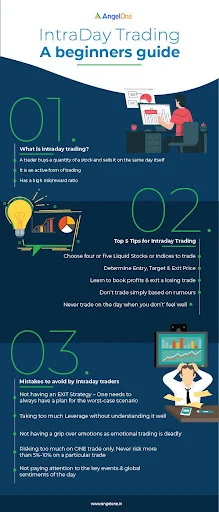
Intraday means ‘within the day’. Hence, intraday trading refers to trading stocks and ETFs during regular trading hours within a single day. You can buy or sell shares within a short period, without having to undergo the tedious process of availing physical share certificates. Intraday trading works on the concept of price movement. You buy shares when the price is low and sell them when the price rises. The difference in both the rates amounts to the profit earned.
Understand the difference between trading and investing
Trading and investing are completely different investing approaches. Understanding how long-term value and growth investment work does not make you inherently adept at intraday trading. The rationale applied behind picking long-term investment does not apply to picking stocks for day trading. Long-term investments are made with the intention of riding out day-to-day market volatility whereas day trading capitalises on market volatility to make a profit.
With the basics in mind, let us take a look at how to do intraday trading in India.
Choose liquid stocks: Day trading requires you to square off the position before the end of the day. If you buy a stock which doesn’t have enough liquidity, you may not be able to sell it when you want to exit. Dealing only in liquid stocks is one of the basic principles of day trading. Adequate liquidity ensures that there is no limitation on the trading volume. Liquid stocks have many buyers and sellers which leads to volatility in the stock price and day traders need volatility to generate profits.
Research before starting: The potential for profits is high in day trading, but so are the chances of loss. Before initiating trades, conduct thorough research and zero in on the shares you want to trade in. Select stocks from a sector you have an understanding of. After finalising the shares, monitor their price movements for some days, along with other metrics such as volume and liquidity before initiating trades.
Choose stocks that move with the market: Price movements can be triggered by various reasons, however, there are certain stocks that mirror the movement of the broader indices. For instance, if the Nifty rises these stocks will rise and vice-versa. A bulk of stocks, however, do not have a set pattern and hence one should be cautious while dealing with them.
Recognise the correct price: For an intraday trade to be profitable, you will have to determine the correct price for entry and the right price to exit. Traders employ different strategies by using support and resistance levels to determine the right entry and exit prices. Some traders square off their positions as soon as the trade becomes profitable, while others ride the momentum. Your strategy may differ, but always be disciplined and stick to the plan.
Set a stop-loss: Brokerages provide substantial leverage for intraday trading, which increases the potential for profit and also for loss. The loss during day trading can be huge, which makes setting a stop loss very important. A stop-loss limit automatically cuts your position as soon as the share price crosses a pre-decided level.
Move with the trend: It is advisable to move with the broader market trend while day trading. When the market is bullish, going long may be a good idea. On the other hand, if the market is bearish, you can go short or wait for stocks to bottom out before entering.
Basic Rules for the Intraday Trader
There are some simple rules that will ensure that a beginner intraday trader can maximise their chances of garnering a profit and minimise losses. These rules include:
- Invest small. You may like the thrill of the stock market but it is unwise to put a significant chunk of your earnings in intraday trading. Put in only that amount that you can afford to lose. Don’t let beginner’s luck or the profits of seasoned traders lure you into putting in more money than you can afford to.
- Always square off your trades at the end of the day. Do not hold onto securities in the false hope that you will get more profits or less losses the next day.
- Keep an eye on the market at all times. You cannot be in business meetings all day or on long flights while the market is on. You need to be vigilant and quick to make the trade when the price is right. You may lose out on a good selling price if you are not monitoring the rise and fall of your chosen stocks.
- Exit as soon as you realise the market has turned unfavourable. Do not wait for the stop-loss conditions to trigger as that may be too late and you may register more losses.
- Do not invest in too many markets at once.
- Pick your market on the basis of the amount of capital you have. Typically, the currency market requires the least amount of capital to trade, while stocks require slightly higher capital amounts.
- Find the right time for your intraday trading and follow that routine religiously.
- With time and experience, work on formulating a proper intraday trading strategy and keep implementing it. The key to intraday trading is to find a strategy that works for you and keep repeating it to maximize profits.
- The best stocks for intraday trading should be high liquidity and have medium to high volatility. For a beginner, it is best to begin by focusing on one or two stocks at a time.

To begin with, Traders use real-time charts to identify the intraday price movement. Along with price monitoring, there are several other tools that help in making your initial trades successful.
Here is a guide of moves and strategies that will help you profit while doing intraday trading:
Advantages of Intraday Trading
There are many pros of day trading in the stock market. Here are some of the key advantages.
1. Instant Earnings
Unlike long-term investments, you can get earnings from day trading almost instantly. Once you exit your trade, depending on your strategy and performance, the profit or loss will be directly reflected in your trading account. You can choose to either reinvest the profits back into your trading capital pool or can withdraw the same by transferring the funds to your bank account.
2. No Overnight Risk
With day trading, as you would not hold your stocks overnight in the market, you can avoid the risk of overnight fluctuations. Many times, the stock price changes between the close of the market and the opening of the market due to news and other sources. This fluctuation can affect the stock price.
3. Make Profits in Bear Markets
A key advantage with day trading is that you can make profits in a bear market as well. Instead of buying a particular stock, you can short sell a stock and buy them later to make profits. You can thereby make profits in both rising as well and falling markets. This advantage is usually not available for investment options.